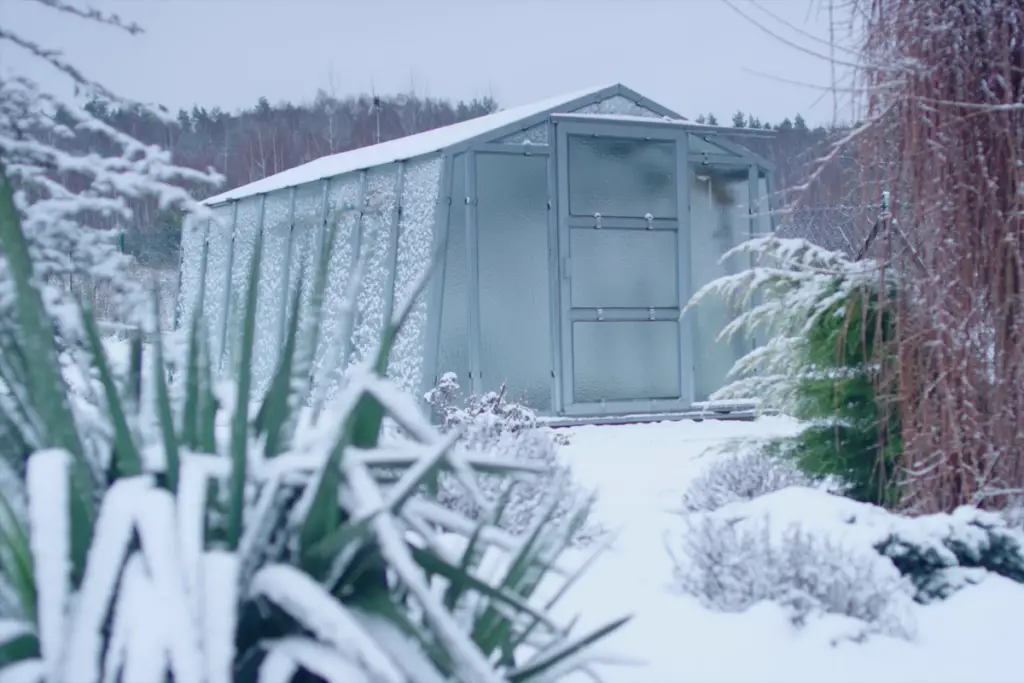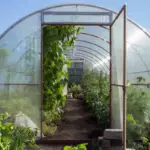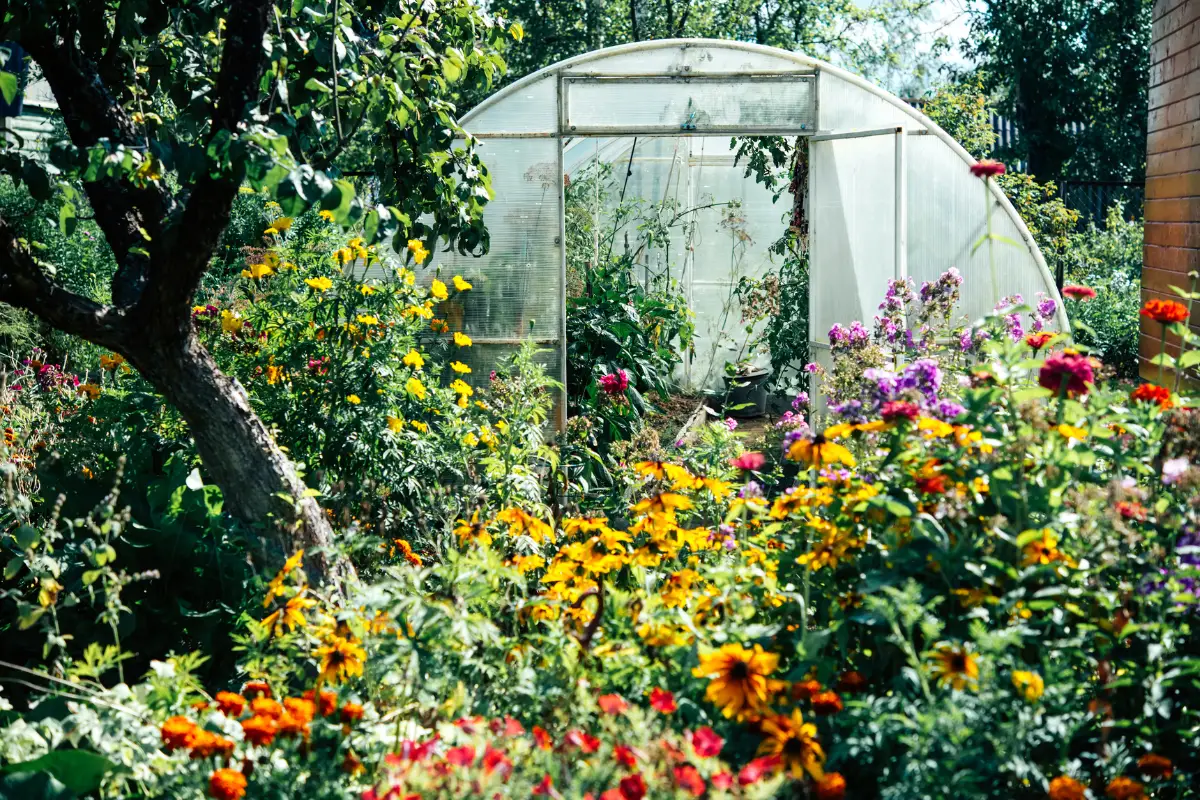Greenhouses are a great way to extend the growing season and protect plants from harsh weather conditions.
However, heating a greenhouse during winter can be expensive, and relying on traditional heating sources may not be environmentally friendly.
Luckily, there are several ways to heat a greenhouse for free using natural and sustainable methods.
One way to heat a greenhouse for free is by using passive solar heating. This involves collecting heat from the sun during the day and releasing it into the greenhouse at night.
To do this, the greenhouse should be oriented towards the south to maximize exposure to the sun.
Additionally, materials such as water barrels or rocks can be placed inside the greenhouse to absorb and release heat as needed.
Another method to heat a greenhouse for free is through composting. Composting generates heat as organic matter decomposes, which can be harnessed to warm the greenhouse.
This can be done by creating a compost pile or using a hotbed, which involves burying composting materials beneath the soil in the greenhouse.
As the materials decompose, they release heat, which warms the soil and air in the greenhouse.

Table of Contents
Understanding Greenhouse Heating Needs
Heating a greenhouse in winter can be a challenging task, especially if you’re on a tight budget.
Before you start looking for ways to heat your greenhouse for free, it’s important to understand the heating needs of your greenhouse.
Factors Affecting Greenhouse Heating Needs
The heating needs of a greenhouse depend on several factors, including:
- Greenhouse Size: The larger the greenhouse, the more heat it will require to maintain the desired temperature.
- Greenhouse Location: The location of the greenhouse can also affect its heating needs. A greenhouse located in a colder climate will require more heat than one located in a milder climate.
- Greenhouse Design: The design of the greenhouse can also affect its heating needs. For example, a greenhouse with a lot of windows will lose more heat than one with fewer windows.
- Greenhouse Insulation: The level of insulation in a greenhouse can also affect its heating needs. A well-insulated greenhouse will require less heat than one with poor insulation.
Calculating Greenhouse Heating Needs
To calculate the heating needs of your greenhouse, you’ll need to consider the following factors:
- Greenhouse Size: Measure the length, width, and height of your greenhouse to determine its volume.
- Greenhouse Location: Determine the average winter temperature in your area.
- Greenhouse Design: Consider the design of your greenhouse and the materials used to build it.
- Greenhouse Insulation: Evaluate the level of insulation in your greenhouse.
Once you have this information, you can use an online greenhouse heating calculator or consult with a professional to determine the heating needs of your greenhouse.
By understanding the heating needs of your greenhouse, you can choose the most effective and efficient way to heat it during the winter months.
Harnessing Solar Energy
Greenhouses can be heated for free by harnessing solar energy. Solar energy can be stored in thermal mass and used to regulate the temperature inside the greenhouse.
There are two main ways to harness solar energy: passive solar heat storage and active solar heat storage.
Passive Solar Heat Storage
Passive solar heat storage is the process of collecting heat from the sun during the day and releasing it into the greenhouse at night.
This can be done by placing thermal mass, such as water barrels or rocks, in the greenhouse.
The thermal mass absorbs the heat during the day and slowly releases it at night, keeping the greenhouse warm.
Table 1: Examples of Thermal Mass Materials
| Material | Thermal Mass Capacity (J/kg*K) |
|---|---|
| Water | 4186 |
| Concrete | 880 |
| Rock | 800 |
Active Solar Heat Storage
Active solar heat storage involves the use of solar panels to collect and store solar energy. The energy is then used to power a heating system in the greenhouse.
There are two types of active solar heat storage systems: on-grid and off-grid.
On-grid systems are connected to the power grid and excess energy can be sold back to the utility company.
Off-grid systems are not connected to the power grid and rely on batteries to store excess energy.
Table 2: Comparison of On-Grid and Off-Grid Solar Systems
| System Type | Advantages | Disadvantages |
|---|---|---|
| On-Grid | Can sell excess energy back to utility company | No power during blackouts |
| Off-Grid | No reliance on power grid | Expensive to install and maintain |
| Can be used in remote locations | Batteries need to be replaced every few years | |
| No monthly electricity bills | Excess energy is wasted if batteries are full |
By harnessing solar energy, greenhouse owners can heat their greenhouses for free and reduce their carbon footprint.
Passive solar heat storage is a simple and cost-effective way to regulate the temperature in the greenhouse, while active solar heat storage provides a more reliable and consistent source of heat.
Utilizing Compost Heat
Compost heat is an effective way to heat a greenhouse in winter for free. Compost is a natural source of heat that can be used to keep the greenhouse warm and provide a healthy environment for the plants.
Here are some ways to utilize compost heat in a greenhouse:
1. Compost Bin
A compost bin is a great way to generate heat in a greenhouse. The compost bin should be placed inside the greenhouse and filled with compost materials.
The compost should be made up of two parts brown to one part green and water. As the compost breaks down, it releases heat, which will keep the greenhouse warm.
The plants can be placed on top of the compost bin to benefit from the heat.
2. Hotbeds
Hotbeds are another way to utilize compost heat in a greenhouse. Hotbeds can be made by placing composting materials in a pit or trench and covering them with soil.
The hotbeds can be used to grow plants directly on top of the composting materials. The heat generated by the composting materials will keep the plants warm and healthy.
3. Compost Pile
A compost pile can also be used to generate heat in a greenhouse. The compost pile should be placed outside the greenhouse and covered with a layer of soil.
The compost pile should be made up of two parts brown to one part green and water.
As the compost breaks down, it releases heat, which will be absorbed by the soil and radiate into the greenhouse.
4. Compost Tea
Compost tea is another way to utilize compost heat in a greenhouse. Compost tea is made by steeping compost in water and using the resulting liquid to water the plants.
The heat generated by the composting materials will be absorbed by the water and transferred to the plants when they are watered.
Implementing Thermal Mass
One of the most common and easiest ways to heat a greenhouse for free in winter is to use thermal mass.
Thermal mass refers to any material that can store heat energy and release it slowly over time.
It helps to even out temperature fluctuations and maintain a stable temperature inside the greenhouse.
Choosing the Right Material
When it comes to selecting the right material for thermal mass, water is the most effective. It can store twice as much heat energy as concrete or stone.
Other good options include bricks, concrete blocks, and clay pots. The material should be dense, heavy and have a high specific heat capacity.
Placement
Thermal mass should be placed strategically in the greenhouse to maximize its effectiveness. The ideal location is in the path of the sun’s rays during the day.
This allows the material to absorb heat energy during the day and release it slowly at night when the temperature drops.
Creating a Heat Sink
To create a heat sink, fill containers such as barrels, drums or large plastic containers with water and place them in the greenhouse. The water will absorb heat during the day and release it at night.
Other Considerations
It is important to note that thermal mass alone may not be enough to heat a greenhouse in extremely cold temperatures.
Other methods such as insulation, passive solar heating, and electrical heating may need to be used in conjunction with thermal mass to maintain a comfortable temperature.
Maximizing Insulation
When it comes to heating a greenhouse in winter for free, insulation is key.
Maximizing insulation can help retain heat and reduce heat loss, which can keep the greenhouse warm without relying on expensive heating systems.
Here are some ways to maximize insulation in a greenhouse:
Use Bubble Wrap
One simple and cost-effective way to insulate a greenhouse is to use bubble wrap. Bubble wrap can be placed on the inside of the greenhouse to trap heat and prevent it from escaping.
The wrap can be easily cut to fit the size of the greenhouse and attached to the walls and roof using tape or clips. This method can be especially effective when combined with other insulation methods.
Install Double Glazing
Double glazing is another effective way to insulate a greenhouse. Double glazing involves installing a second layer of glass or polycarbonate on the inside of the greenhouse.
This creates an air gap between the two layers, which helps to trap heat and reduce heat loss.
Double glazing can be more expensive than other insulation methods, but it can also be more effective.
Use Insulated Panels
Insulated panels can also be used to insulate a greenhouse. These panels are typically made of polycarbonate and have a layer of insulation built in.
They can be easily installed on the walls and roof of the greenhouse and can help to trap heat and reduce heat loss.
Insulated panels can be more expensive than other insulation methods, but they can also be more effective and durable.
Seal Gaps and Cracks
Gaps and cracks in the greenhouse can allow heat to escape and cold air to enter. Sealing these gaps and cracks can help to maximize insulation and keep the greenhouse warm.
Gaps and cracks can be sealed using weather stripping, caulking, or foam insulation. It’s important to regularly inspect the greenhouse for gaps and cracks and seal them as soon as possible.
Use Thermal Mass
Thermal mass involves using materials that can absorb and retain heat, such as water barrels or concrete blocks.
These materials can be placed inside the greenhouse to absorb heat during the day and release it at night, helping to keep the greenhouse warm.
This method can be especially effective when combined with other insulation methods.
By maximizing insulation in a greenhouse, it’s possible to keep the greenhouse warm in winter without relying on expensive heating systems.
Using bubble wrap, double glazing, insulated panels, sealing gaps and cracks, and using thermal mass are all effective ways to maximize insulation and keep a greenhouse warm.
Using Recycled Materials
One of the best ways to heat a greenhouse in winter for free is to use recycled materials.
By repurposing items that would otherwise be thrown away, gardeners can save money and reduce their carbon footprint.
Here are some ideas for using recycled materials to heat a greenhouse:
- Old Windows – If you have old windows lying around, you can use them to create a greenhouse that will trap heat from the sun. Simply build a frame and attach the windows to it. You can also use old windows to create a cold frame, which is a smaller structure that can be used to protect plants from frost.
- Plastic Bottles – Plastic bottles can be filled with water and used as thermal mass to store heat. Simply fill the bottles with water and place them in the greenhouse. During the day, the water will absorb heat from the sun, and at night, it will release the heat back into the greenhouse.
- Cardboard Boxes – Cardboard boxes can be used to insulate the greenhouse and trap heat. Simply line the walls and roof of the greenhouse with cardboard boxes, making sure to leave space for air to circulate.
- Composting Materials – Composting materials generate heat as they decompose, making them a great source of heat for a greenhouse. Simply create a compost pile inside the greenhouse and let it decompose. The heat generated by the compost will help to keep the greenhouse warm.
- Old Rugs or Carpet – Old rugs or carpet can be used to insulate the floor of the greenhouse and trap heat. Simply lay the rugs or carpet on the floor of the greenhouse, making sure to leave space for air to circulate.
By using recycled materials to heat a greenhouse, gardeners can save money and reduce their environmental impact.
These materials are often readily available and can be repurposed in creative ways to create a warm and cozy environment for plants.
Conclusion
Heating a greenhouse in winter can be a challenge, but it doesn’t have to be expensive.
With a little creativity and ingenuity, gardeners can keep their plants warm and thriving without breaking the bank.
One of the most effective ways to heat a greenhouse for free is to use passive solar heating.
By collecting heat from the sun during the day and releasing it into the greenhouse at night, gardeners can maintain a consistent temperature without relying on expensive heating systems.
Another option is to use composting materials to generate heat. Hotbeds made from composting materials can provide gentle heat to fend off frosts and keep plants warm.
Composting also breaks down organic waste into nutrient-rich soil, making it a win-win for gardeners.
Using water containers, such as barrels or jugs, is another simple and effective way to heat a greenhouse.
Water has a high thermal mass, which means it can absorb and store heat. By placing water containers in the greenhouse, gardeners can create a heat sink that will release warmth slowly over time.
Finally, insulating the greenhouse can also help to keep plants warm in the winter. By adding a layer of insulation to the walls, roof, and floor, gardeners can reduce heat loss and maintain a more consistent temperature.
- How to Dry Basil Leaves: A Professional Guide
- Is an Avocado a Fruit or Vegetable? Simple Answer and Explanation
- Does Pineapple Have Seeds? Exploring the Anatomy of Pineapples
- Blooming Through Winter: Can I Grow Vegetables Indoors in the Winter?
- What Can You Grow in a Greenhouse All Year Round: A Guide to Year-Round Greenhouse Gardening
- Are Blueberries Blue? Debunking the Myth of Their Color
















